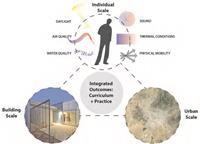Interscalar Design and Health Research Partnership: Research Integration into Curriculum and Practice

A new vision for environmental health extends beyond the traditional removal of negative factors that cause illness and disease to embrace aspects of the built and natural environment that support physical health and emotional wellbeing. An interdisciplinary team of biomedical, public health, integrative medicine, architecture, landscape architecture, and planning disciplines is conducting research at various scales to inform innovative concepts for addressing the interrelated physiological and biopsychosocial challenges. The research framework presented here focuses on four significant aspects of this ongoing multidisciplinary effort: individual scale, community scale, building scale, and integrated outcomes for implementation of education and curriculum into practice. Primary physiological impacts of built environment factors upon health and wellbeing are documented at the individual level while biopsychosocial impacts are investigated at the community level with a focus on resiliency. These research results are implemented into academic design/build outreach practice for underserved communities, and also inform core fundamentals of environmental factors for dissemination in architecture curriculum technical courses. The results of this research intend for the evidence needed to support holistic health and wellbeing in the design, construction, and maintenance of built environments.


Add comment
Log in to post comments